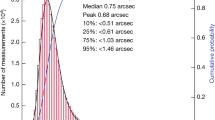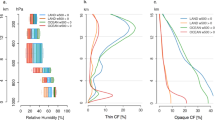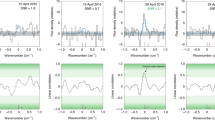Abstract
AN interesting variation in the height of maximum density of the twilight sodium layer was observed at Victoria, British Columbia, during a year long series of observations, between February 4, 1967, and February 29, 1968, using a birefringent photometer directed towards the zenith sky. It has been found that, in general, the height of the sodium layer during the morning twilight period is lower than the evening twilight layer by an amount which varies throughout the year. The difference in height appears to be greatest around the times of the equinoxes amounting to approximately 5 km, and least near the solstices, when the difference diminishes to zero.
This is a preview of subscription content, access via your institution
Access options
Subscribe to this journal
Receive 51 print issues and online access
$199.00 per year
only $3.90 per issue
Buy this article
- Purchase on Springer Link
- Instant access to full article PDF
Prices may be subject to local taxes which are calculated during checkout
Similar content being viewed by others
References
Blamont, J. E., and Donahue, T. M., J. Geophys. Res., 69, 4093 (1964).
Hunten, D. M., J. Atmos. Terr. Phys., 5, 44 (1954).
Author information
Authors and Affiliations
Rights and permissions
About this article
Cite this article
SULLIVAN, H., ROBERTS, M. Height of the Twilight Sodium Layer: Evening–Morning Effect observed at Victoria, British Columbia, from February 1967 to February 1968. Nature 220, 361–362 (1968). https://doi.org/10.1038/220361a0
Received:
Published:
Issue Date:
DOI: https://doi.org/10.1038/220361a0
Comments
By submitting a comment you agree to abide by our Terms and Community Guidelines. If you find something abusive or that does not comply with our terms or guidelines please flag it as inappropriate.



